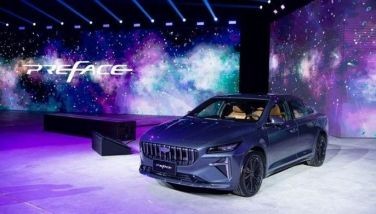Hatchback head-on: Hyundai Matrix vs. Chevrolet Aveo vs. Kia Rio
September 17, 2003 | 12:00am
Going through the motions of test-driving and studying cars can be a tedious and trying experience. One can only do so much when comparing the pros and cons of vehicles whose engineers have spent years perfecting their respective products’ performance levels. Still, the fun lies in discovering little surprises here and there. Not too long ago, we met up with three vehicles whose penchant for coming up with surprises came almost like second nature. Welcome to the world of the all-new hatchback, where sedan fans and SUV freaks can get stupefied at almost every turn...
One of the first things that’s obvious from the start is how much smaller compact hatchbacks are when compared to even the littlest of entry-level sedans —at least on the outside. Hyundai’s Matrix MPV (Multi-Purpose Vehicle), for example, looks every much like a very little brother to its hulking predecessor, the Starex. One look at Chevrolet’s Aveo, on the other hand, and you’d think it’s as comfortable on the inside as a VW Beetle. Kia’s Rio, meanwhile, is often compared to its popular predecessor, the Pride, which hides the fact that it’s really much more spacious on the inside. Not one among the three look like they can comfortably fit passengers the way a Toyota Vios or a Honda City can. But nothing could be farther from the truth.
The Matrix combines the design prowess of renowned Italian carmaker Pininfarina (yes, they of Ferrari fame) with Hyundai’s own fondness for providing smart interiors. Despite its lack of length (4,025 mm), the Matrix’s high roof design (1,635 mm) makes it easy for it to fit the vertically-gifted amongst us. Its small body belies a truly spacious interior that’s packed to the brim with storage options that put many an SUV to shame. The Matrix has cupholders galore (six in all), fold-up seat back trays, various storage trays and boxes (from center console trays to under the seat trays to hidden storage boxes beneath the steering wheel and within the luggage compartment) and even an extra power outlet at the back of the vehicle. It presents itself as the ultimate utility vehicle (hence the "MPV" moniker) that’s perfect for long drives for small groups. It provided enough room — and comfort — for a certified shopaholic and her husband (yours truly), who both gave the car’s roomy interiors the thumbs up.
Chevrolet’s Aveo, meanwhile, looks very much like a stylized mini-Euro that has touches of a retro-Mini Cooper to boot. The "circle" motif prevalent in the interiors gives a certain cute-yet-classy feel to the car. Though much shorter than the Matrix (3,880 mm), it catches up in the height department (1,495), which again makes for spacious headroom. And though equipped with only (well, when compared to the Matrix, anyway) four cupholders, it still gives other, much bigger vehicles a run for their money in the comforts department. Still, it didn’t give as much mobility and flexibility as the Matrix. One thing this baby has that other vehicles in its class don’t is a built-in keyless entry system which is often taken for granted by manufacturers but means a whole lot to buyers. It also has a decent sound system (S/DIN, single in-dash CD) that’s slightly better than its competitors’.
The Kia Rio, meanwhile, is easily the longest of the three (4,240 mm) — as such, it also gives up on the height department (1,420). All this however, translates to versality on a level neither of the two can obviously compete in — trunk space. A whopping 449 liters can fit in the Rio hatchback’s trunk and an even more impressive 1,227 liters with the rear seat folded flat. Which brings us to the Rio’s reason for being. With that kind of versatility for cargo instead of people, the practicality for such a car could be best maximized by home-makers on the go, which by the way seems to be where the exterior design is also focused. It’s a picture perfect car for moms as it hides under the moniker of a hatchback but can actually function as a station wagon.
One of the common misnomers people have of hatchbacks is that they lack the power necessary for speed-hungry motorists. This writer found it particularly pleasant to realize that all three vehicles have engine displacements that put a few bigger vehicles to shame. The Matrix, for example, is powered by a 4-cylinder-in-line double overhead cam 16-valve MFI engine. It peaks at a maximum of 103ps@5,800rpm. Not bad for a little vehicle that’s perceived to be a slowpoke. The only thing that could be quite bothersome about the Matrix’s 1600 powerhouse is its penchant for screaming when the going gets tough. Yes, it can accelerate with the best of them, but it also sounds like it’s having a tough time whenever it does.
The Aveo, on the other hand, does not carry numbers as impressive as that of the Matrix with a 1.5 liter single overhead cam powertrain that generates 83ps@5600rpm, but it does have better insulation that keeps outside noise from disturbing the cabin. We drove the 4-speed transaxle automatic version of the Matrix up the mountains of Antipolo and found the Matrix able and willing but also a bit noisy. The 5-speed manual version of the Aveo made its way to the traffic-infested North Expressway, carried four passengers and a gazillion Hormel hotdog stuffed grocery bags but still managed to accelerate all the way up to 120kph without much noise or rattling before we decided it was getting a bit too speedy for comfort — especially in a vehicle as small as the Aveo.
Kia’s Rio is also a big surprise, perhaps because of the Korean carmaker’s repuatation as the provider of the most affordable of entry-level cars in the country. A private joke back in college had us belittling those who allowed themselves to be overtaken by a Kia Pride as, well, without "pride". The Rio’s 1.5 DOCH water-cooled four cylinder with twin camshafts effectively puts an end to that misnomer. The Rio is proof that Kia has gone far in the development of engines better suited to the needs of a more stringent market. Still, like the Matrix, its weakness lies in poor sound insulation. The noisier the car from the inside, the more people tend to mistake it for a "weak" automobile. Perhaps this is one area of development that the Korean engineers can develop further in future projects.
If you take a really close look at all three cars, you’d think they were targeting different markets altogether. Hyundai did the right thing by hooking up with Pininfarina and getting some Italian designer clothes to adorn their new baby. The Matrix looks like it’s in a class all by itself, at least on the outside. This is one vehicle that won’t look like anything else on the road even if you put the ubiquitous mag wheels — whatever size — on it. Chevrolet’s Aveo, meanwhile, takes the more traditional approach that suggests a more conventional inclination. At first glance it can be mistaken for, say, a Toyota Echo — albeit a slightly larger one. In other words, it doesn’t really stand out in a crowd. Its saving grace is the Euro styled see-through, jewel-effect, two-element head lamps and its crystal-effect foglamps, which by the way, provide excellent lighting. Lastly, as we stated earlier, the Rio looks like it again has its target market in its sights with the way the Rio is built. No doubt it looks like a car fit for your mom or your sister, but it’s not the kind that "kuya" would be in a hurry to take out for a date. This kind of niche marketing has proven successful for Kia before, and it looks like they want to take the Rio down that same line.
The Matrix is perfect for the more adventurous yet practical occasional out-of-towner. The Aveo is more for the economy conscious city dweller. And the Rio is perfect for the busy working mom who’s major concerns revolve around versatility for cargo.
The bottom line here is that the vehicles are not of the traditional mold, even if the Aveo and the Rio look the part. The Matrix is full of surprises on the inside and is quite unique on the outside, while the Aveo’s size camouflages a bundle of energy wrapped in deceptive clothing and the Rio’s hatchback design hides a functional wagon inside. Oh, and all three are pretty fuel-efficient, too. The Hyundai Matrix retails at P625,000 for the manual transmission and P680,000 for the automatic. The Chevrolet Aveo goes for P575,000 for the manual transmission and P615,000 for the automatic transmission. The Kia Rio hatchback manual transmission goes for P539,000 while the automatic version sells for P619,000. They are all "fun" drives built on basic platforms — no nano-technology fit for Star Trek and all that brouhaha — which make them exciting new additions to the local automotive scene, but not revolutionary ones that will change the market forever.
The Matrix combines the design prowess of renowned Italian carmaker Pininfarina (yes, they of Ferrari fame) with Hyundai’s own fondness for providing smart interiors. Despite its lack of length (4,025 mm), the Matrix’s high roof design (1,635 mm) makes it easy for it to fit the vertically-gifted amongst us. Its small body belies a truly spacious interior that’s packed to the brim with storage options that put many an SUV to shame. The Matrix has cupholders galore (six in all), fold-up seat back trays, various storage trays and boxes (from center console trays to under the seat trays to hidden storage boxes beneath the steering wheel and within the luggage compartment) and even an extra power outlet at the back of the vehicle. It presents itself as the ultimate utility vehicle (hence the "MPV" moniker) that’s perfect for long drives for small groups. It provided enough room — and comfort — for a certified shopaholic and her husband (yours truly), who both gave the car’s roomy interiors the thumbs up.
Chevrolet’s Aveo, meanwhile, looks very much like a stylized mini-Euro that has touches of a retro-Mini Cooper to boot. The "circle" motif prevalent in the interiors gives a certain cute-yet-classy feel to the car. Though much shorter than the Matrix (3,880 mm), it catches up in the height department (1,495), which again makes for spacious headroom. And though equipped with only (well, when compared to the Matrix, anyway) four cupholders, it still gives other, much bigger vehicles a run for their money in the comforts department. Still, it didn’t give as much mobility and flexibility as the Matrix. One thing this baby has that other vehicles in its class don’t is a built-in keyless entry system which is often taken for granted by manufacturers but means a whole lot to buyers. It also has a decent sound system (S/DIN, single in-dash CD) that’s slightly better than its competitors’.
The Kia Rio, meanwhile, is easily the longest of the three (4,240 mm) — as such, it also gives up on the height department (1,420). All this however, translates to versality on a level neither of the two can obviously compete in — trunk space. A whopping 449 liters can fit in the Rio hatchback’s trunk and an even more impressive 1,227 liters with the rear seat folded flat. Which brings us to the Rio’s reason for being. With that kind of versatility for cargo instead of people, the practicality for such a car could be best maximized by home-makers on the go, which by the way seems to be where the exterior design is also focused. It’s a picture perfect car for moms as it hides under the moniker of a hatchback but can actually function as a station wagon.
The Aveo, on the other hand, does not carry numbers as impressive as that of the Matrix with a 1.5 liter single overhead cam powertrain that generates 83ps@5600rpm, but it does have better insulation that keeps outside noise from disturbing the cabin. We drove the 4-speed transaxle automatic version of the Matrix up the mountains of Antipolo and found the Matrix able and willing but also a bit noisy. The 5-speed manual version of the Aveo made its way to the traffic-infested North Expressway, carried four passengers and a gazillion Hormel hotdog stuffed grocery bags but still managed to accelerate all the way up to 120kph without much noise or rattling before we decided it was getting a bit too speedy for comfort — especially in a vehicle as small as the Aveo.
Kia’s Rio is also a big surprise, perhaps because of the Korean carmaker’s repuatation as the provider of the most affordable of entry-level cars in the country. A private joke back in college had us belittling those who allowed themselves to be overtaken by a Kia Pride as, well, without "pride". The Rio’s 1.5 DOCH water-cooled four cylinder with twin camshafts effectively puts an end to that misnomer. The Rio is proof that Kia has gone far in the development of engines better suited to the needs of a more stringent market. Still, like the Matrix, its weakness lies in poor sound insulation. The noisier the car from the inside, the more people tend to mistake it for a "weak" automobile. Perhaps this is one area of development that the Korean engineers can develop further in future projects.
The Matrix is perfect for the more adventurous yet practical occasional out-of-towner. The Aveo is more for the economy conscious city dweller. And the Rio is perfect for the busy working mom who’s major concerns revolve around versatility for cargo.
The bottom line here is that the vehicles are not of the traditional mold, even if the Aveo and the Rio look the part. The Matrix is full of surprises on the inside and is quite unique on the outside, while the Aveo’s size camouflages a bundle of energy wrapped in deceptive clothing and the Rio’s hatchback design hides a functional wagon inside. Oh, and all three are pretty fuel-efficient, too. The Hyundai Matrix retails at P625,000 for the manual transmission and P680,000 for the automatic. The Chevrolet Aveo goes for P575,000 for the manual transmission and P615,000 for the automatic transmission. The Kia Rio hatchback manual transmission goes for P539,000 while the automatic version sells for P619,000. They are all "fun" drives built on basic platforms — no nano-technology fit for Star Trek and all that brouhaha — which make them exciting new additions to the local automotive scene, but not revolutionary ones that will change the market forever.
BrandSpace Articles
<
>
- Latest
Latest
Latest
September 30, 2024 - 4:26pm
By EC Toledo | September 30, 2024 - 4:26pm
September 26, 2024 - 3:30pm
September 26, 2024 - 3:30pm
August 16, 2024 - 11:00am
By Euden Valdez | August 16, 2024 - 11:00am
Recommended



























